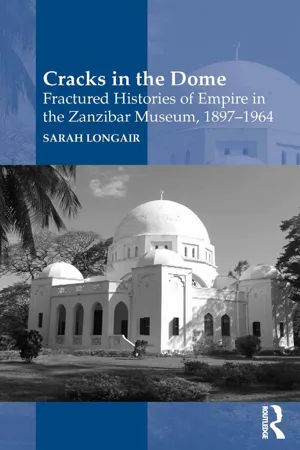History
Zanzibar
Zanzibar is an archipelago off the coast of East Africa with a rich history shaped by trade, slavery, and colonialism. It was a major hub for the Indian Ocean trade, particularly in spices and ivory. Zanzibar also played a significant role in the Arab slave trade. The islands eventually became a British protectorate before gaining independence and merging with Tanganyika to form Tanzania.
Written by Perlego with AI-assistance
Related key terms
1 Key excerpts on "Zanzibar"
- Sarah Longair(Author)
- 2016(Publication Date)
- Routledge(Publisher)
45 Glassman also highlights the importance of the generation of Arab intellectuals and teachers who were trained under L. W. Hollingsworth in the new Teacher Training School from 1923. This group reciprocally influenced Hollingsworth and W. H. Ingrams in their research into, and publications about, the history of Zanzibar. This book brings important new evidence to light to build on Glassman’s work by examining how the Museum gave this historical interpretation physical form. It is therefore possible to reposition the Museum’s historical narrative as one that was informed by a locally created concept of history, rather than dictating it.In order to untangle these intersecting ideas of history and to reveal how the Museum was influenced by, and itself influenced, constructions of the past, it is necessary to outline the broader history of Zanzibar and some of the key historiographical interpretations.Pre-Protectorate History
The history of Zanzibar can be best understood by considering its participation in Indian Ocean trading networks. People, objects and ideas had circulated through this oceanic space for millennia. The earliest references to the island in western literature are found in the Periplus of the Erythraean Sea , which describes a vast network of trade and commerce around the Indian Ocean.46 The island of Men(o)uthias mentioned in this Greek guide to navigation and trading opportunities has been identified with Unguja.47 The twice-yearly monsoon winds enabled traders from the Indian Ocean rim to circulate and exchange their goods, laying the foundations of the islands’ cosmopolitan coastal culture. This sophisticated mercantile population, which would become known as the Swahili, developed along the East African coast. Islam gradually became established as the dominant coastal religion with waves of immigrants from Arabia and the Persian Gulf.48 Archaeological finds and ruins of sizeable towns along the coast testify to the prosperity and extent of the Swahili city-states. The development of this network of Swahili coastal states was known for much of the period in question as the ‘Zenj Empire’, tying its development closely to influence from Arabia, through the arrival of the fabled ‘Shirazi’ princes from Persia. Archaeological research in the post-colonial era has uncovered evidence from the first millennia of trading towns on the coast established by Bantu- and Cushitic-speaking communities settling on the coast.49
Learn about this page
Index pages curate the most relevant extracts from our library of academic textbooks. They’ve been created using an in-house natural language model (NLM), each adding context and meaning to key research topics.
